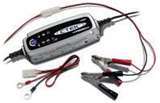LONDON--June 20, 2013: There are a number of different types of lead acid batteries, which are differentiated by the way in which the electrolyte is stored, and using the incorrect battery charger can cause lasting damage, says CTEK, a global battery protection brand.
Batteries store electrical energy that is generated when the vehicle is running or when a charging device is attached. Connected cells, each comprising a cell pack with interleaved positive and negative plates, form a single output and individually they have a nominal voltage of two volts; 12V car batteries consist of six cell elements. The cells are closed with a cover and an opening allows the cells to be filled with electrolyte.
In a wet-cell battery, cells are filled with a solution made up of 65 per cent water and 35 per cent sulphuric acid. This liquid causes a chemical reaction that produces electrons. A calcium battery is effectively also a wet battery, but the alloys in the plates mean fluid isn't lost and the unit doesn't self-discharge in the same way. This type of battery can be sealed and it doesn't require topping up.
Absorbent glass mat (AGM) and gel types are also sealed batteries. With AGM batteries, the absorbent glass fleece material solidifies the electrolyte, which acts as a separator between the electrodes. This battery construction not only withstands large shocks, but allows for faster reactions, so is used with start-stop technology. In a gel battery, the addition of silicic acid causes the electrolyte to solidify into a gel mass, which lowers the risk of acid spillage and enhances the charge and discharge cycle. This means there is a greater chance of recovery after a deep discharge.
Not all battery chargers are designed to be used on each of these four types and if a charger is utilised incorrectly, the vehicle owner may end up needing to purchase a new battery. Katariina Stahl, director of sales and marketing at CTEK, explains the solution for any driver: "All CTEK chargers are created with the complexities of batteries front of mind and when connected the patented technology will recognise the characteristics of the particular battery type. AGM batteries are increasingly popular in newer cars, so, when it's time to change models, drivers don't have to worry about buying a new charger; the same CTEK 12V battery charger will service the new model on the driveway. Furthermore, our chargers can be used across vehicle types so a boat, motorbike or caravan battery can also be charged with just one smart battery charger."



